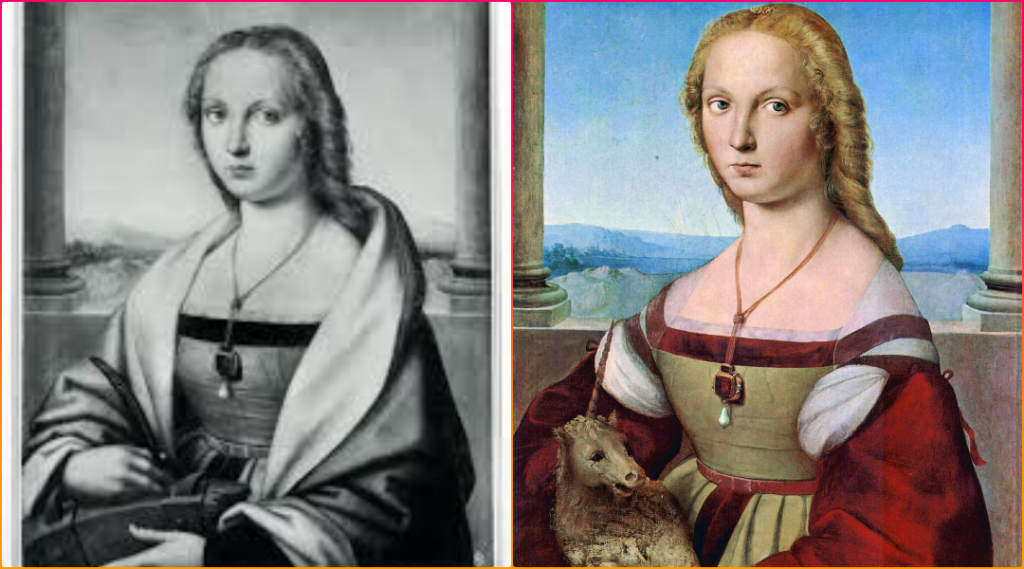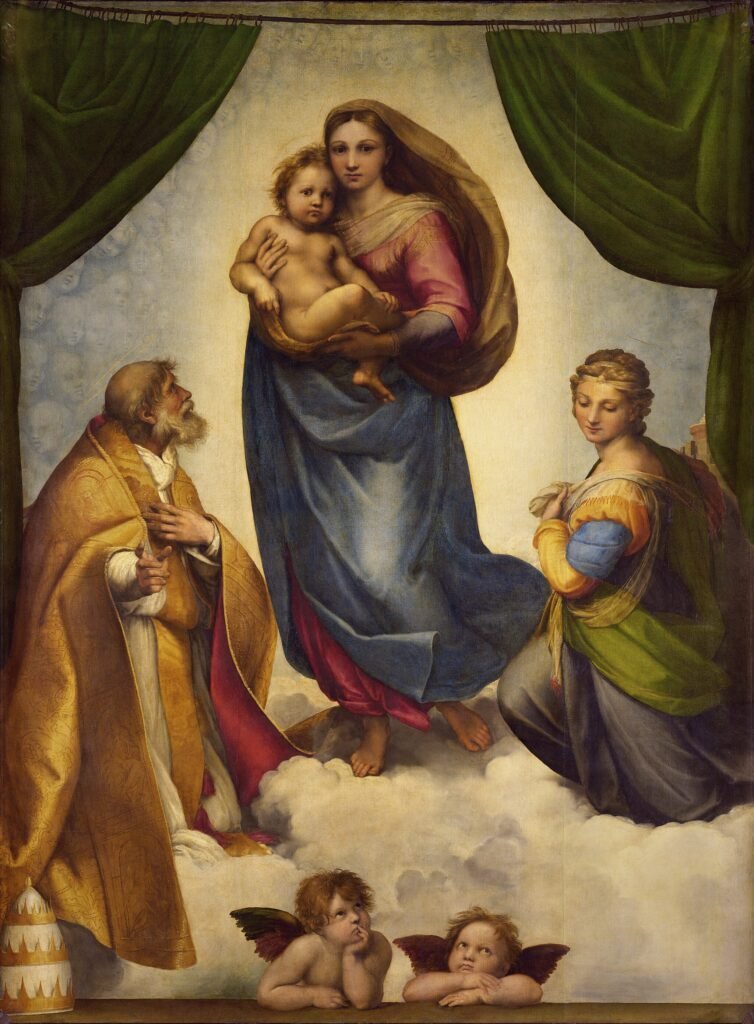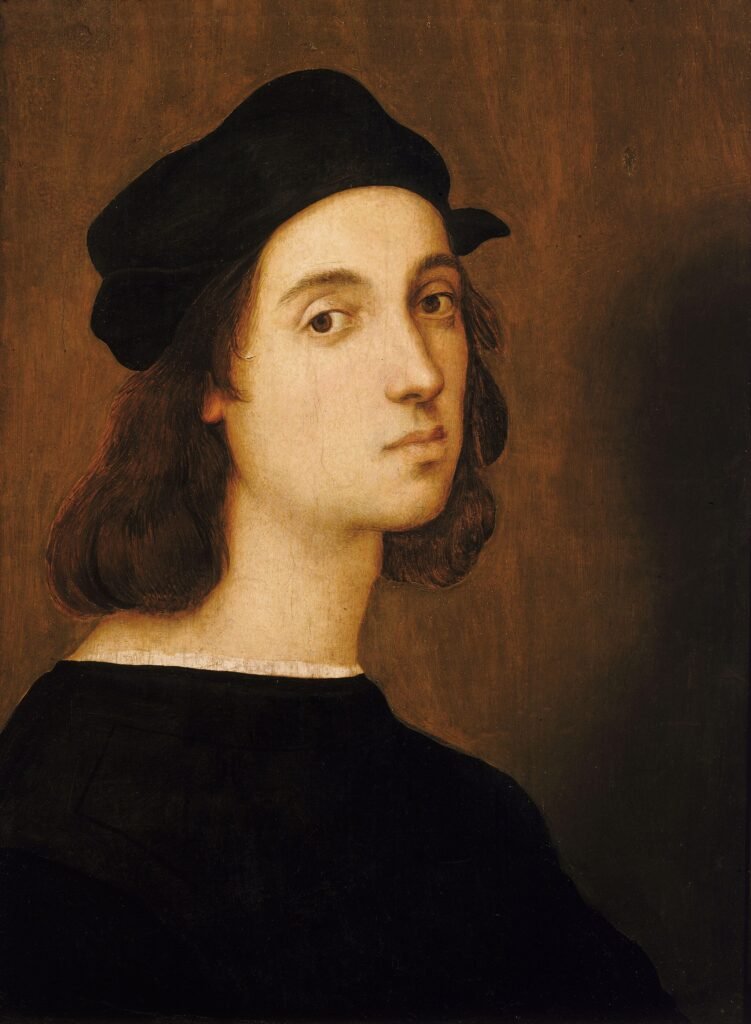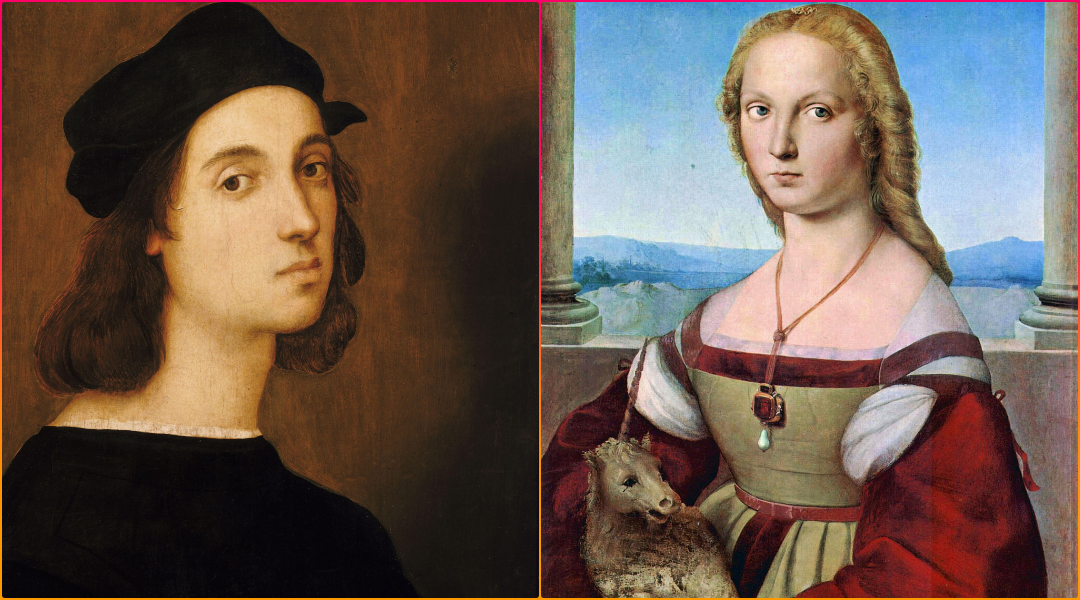On April 6th, we celebrate the Raphae’s birthday, one of the greatest masters of the Italian Renaissance: Born in 1483 in Urbino, Italy, Raphael Sanzio was popular for his divine balance, graceful compositions, and emotional clarity, Raphael left behind a legacy that continues to captivate centuries later. While many know him for monumental works like The School of Athens or the sublime Sistine Madonna, one of his most enigmatic portraits—St Catherine of Alexandria—has recently drawn attention for a very different reason: not for what we see, but for what lies beneath.
Thanks to modern conservation techniques, art historians have discovered that beneath the image of St Catherine holding a unicorn, and beneath even that unicorn, a small dog was once painted on her lap. Yes—a hidden dog beneath a hidden unicorn. This multi-layered mystery has opened a new chapter in the understanding of Raphael’s evolving symbolism and artistic process.
From Noble Saint to Mythical Beast: The Painting’s Many Faces

Raphael painted St Catherine of Alexandria (often also known as Lady with a Unicorn) around 1505, during a period when he was experimenting with influences from Leonardo da Vinci. The painting depicts a poised young woman seated against a hazy landscape, with a mythical unicorn nestled in her arms. Yet this wasn’t always the case.
The painting was first attributed to Perugino in 1730, however a restoration of the painting in 1934–36 confirmed the artwork as Raphael’s a fact always advocated by art historian Roberto Longhi. In the 17th century, the painting was altered significantly to transform the woman into St Catherine, the Christian martyr. A spiked wheel and palm frond—symbols of her martyrdom—were painted in, while the unicorn was overpainted, possibly deemed too pagan or frivolous for a saint. The unicorn disappeared from public view for centuries, until a 1930s restoration stripped away the newer layers and brought Raphael’s original unicorn back into the light.
Beneath the Unicorn: A Small, Symbolic Dog
But the biggest surprise came in 1959, when art conservators used X-ray radiography to peer even deeper under the layers of pigment. What they found startled even seasoned Raphael scholars: before the unicorn, a small dog had been painted on the lady’s lap. A gentle, domesticated creature, typical of the toy spaniels often used in portraits of brides and noblewomen, the dog had been painted over—not once, but twice—first replaced by the unicorn, and then later concealed altogether by the emblems of sainthood.
The change is more than aesthetic. In Renaissance symbolism, dogs represented fidelity and loyalty, common in betrothal portraits. By contrast, unicorns symbolized chastity and purity, often linked to virgins and the Virgin Mary herself. Raphael’s decision to replace the dog with a unicorn speaks volumes about how fluid identity and meaning were in portraiture—and possibly even about the shifting status or role of the sitter.
Animal Symbols in Raphael’s Work: Loyalty, Purity, and the Divine

While Lady with a Unicorn is the most talked-about of Raphael’s paintings for animal symbolism today, it’s far from the only one. Throughout his career, Raphael made careful use of animals as symbolic elements to reinforce themes or highlight hidden narratives.
In his Madonna del Cardellino (Madonna of the Goldfinch), a goldfinch—a symbol of Christ’s Passion—is gently held by the Christ child. In other devotional works, lambs (symbolizing innocence and sacrifice) appear. Animals in Raphael’s paintings were not mere decorations; they were part of the theological and moral messaging of the image.
That Raphael originally included a dog, then replaced it with a unicorn, before it was all hidden by symbols of sainthood, gives us a time-lapsed view of the evolving values imposed on the painting—by Raphael and by those who later altered it.
A Renaissance Puzzle Unfolds

As we honor Raphael’s birthday, this rediscovery is a testament not just to his brilliance, but to the mystery and magic of art itself. What was once hidden now adds another layer to the story. Beneath the unicorn—once thought to be the true symbol—waits a humble dog, reminding us that every masterpiece has more than one story to tell.
Through X-rays and patience, science and art have come together to resurrect that forgotten story. And in doing so, they’ve given us a whole new way to appreciate one of the Renaissance’s most beautiful enigmas.
#DailyMoment

Andrew Alpin from India is the Brand Manager of Doggo digest. Andrew is an experienced content specialist and social media manager with a passion for writing. His forte includes health and wellness, Travel, Animals, and Nature. A nature nomad, Andrew is obsessed with mountains and loves high-altitude trekking. He has been on several Himalayan treks in India including the Everest Base Camp in Nepal.






